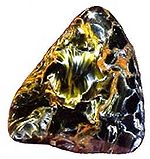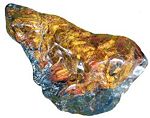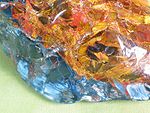
Pietersite
Encyclopedia



Namibia
Namibia, officially the Republic of Namibia , is a country in southern Africa whose western border is the Atlantic Ocean. It shares land borders with Angola and Zambia to the north, Botswana to the east and South Africa to the south and east. It gained independence from South Africa on 21 March...
, Africa
Africa
Africa is the world's second largest and second most populous continent, after Asia. At about 30.2 million km² including adjacent islands, it covers 6% of the Earth's total surface area and 20.4% of the total land area...
. After his discovery, he registered the find in the mineral records of Britain. His discovery was published in 1964, and the material was named pietersite. Currently there are only two known sources of pietersite; China
China
Chinese civilization may refer to:* China for more general discussion of the country.* Chinese culture* Greater China, the transnational community of ethnic Chinese.* History of China* Sinosphere, the area historically affected by Chinese culture...
and Africa. These two forms of pietersite are similar but still somewhat different from each other. The Chinese pietersite's fibrous mineral is a magnesium
Magnesium
Magnesium is a chemical element with the symbol Mg, atomic number 12, and common oxidation number +2. It is an alkaline earth metal and the eighth most abundant element in the Earth's crust and ninth in the known universe as a whole...
-rich alkalic amphibole
Amphibole
Amphibole is the name of an important group of generally dark-colored rock-forming inosilicate minerals, composed of double chain tetrahedra, linked at the vertices and generally containing ions of iron and/or magnesium in their structures.-Mineralogy:...
. The African (Namibian) variety is mainly crocidolite.
The China form of pietersite is said to have been discovered in 1993, but did not come to market until 1997. This China pietersite exhibits slightly different color variations from Mr. Pieter's original mineral, but both are beautiful and are now universally recognized as pietersite.
The material found in China was formed from a mineral very similar to crocidolite, named torendrikite. Chinese pietersite has striking combinations of gold, red and blue color segments which sometimes also includes a deep golden brown color. Regardless of the source, pietersite will always have brecciated, fibrous bands of blue, gold and/or red tiger eye type fibers in quartz
Quartz
Quartz is the second-most-abundant mineral in the Earth's continental crust, after feldspar. It is made up of a continuous framework of SiO4 silicon–oxygen tetrahedra, with each oxygen being shared between two tetrahedra, giving an overall formula SiO2. There are many different varieties of quartz,...
. The fibrous structure in pietersite has been folded, stressed, even fractured and/or broken apart via the Earth's geologic processes. The fibrous materials have then been reformed and naturally recemented together by quartz. Stones and crystals that go through this process are referred to as brecciated, creating a finished product with multiple colors, hues and superb chatoyancy
Chatoyancy
In gemology, chatoyancy , or chatoyance, is an optical reflectance effect seen in certain gemstones. Coined from the French "œil de chat," meaning "cat's eye," chatoyancy arises either from the fibrous structure of a material, as in tiger eye quartz, or from fibrous inclusions or cavities within...
.
While pietersite has the lovely chatoyancy of tiger eye, it is not found in continuously structured bands or fibers, more in swirls, swathes and fibrous (sometimes linear) segments. Thus the structure of the fibrous streaks in pietersite may appear rather chaotic, and can flow or exist in many directions side-by-side like bold paint strokes.
Colors include various blues, golds and reds, that may appear together or alone. Blue is the rarest color, followed by red. The blues range from a baby blue to dark midnight hue. Golds can be light to very deep and rich, sometimes having a reddish hue. All fibrous color variations will have a superb and striking chatoyancy, the bright and subtly changing shimmer of color that moves along the surface of a gemstone as it is viewed from varying angles.

